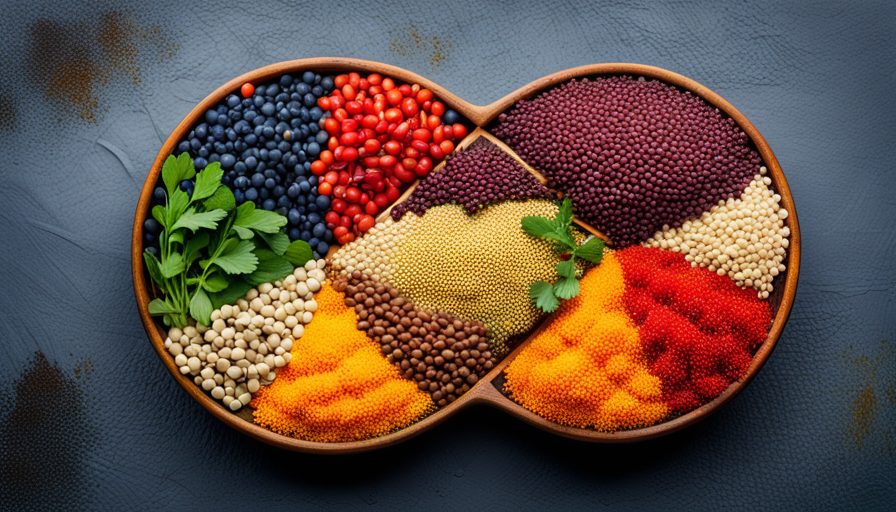Are you ready to unlock the full potential of your raw food diet?
Imagine a world where every bite you take is packed with the maximum amount of nutrients your body needs to thrive. With the right strategies, you can increase the absorption of essential vitamins and minerals from your raw food diet, giving your body the fuel it craves.
It all starts with proper food preparation – by incorporating techniques like fermentation, soaking, and sprouting, you can enhance the availability of nutrients in your meals. Pairing foods strategically, including healthy fats, and balancing macronutrients are also key to optimizing nutrient absorption.
Using high-quality ingredients and avoiding excessive fiber intake are additional steps to consider. But perhaps the most important aspect is listening to your body’s needs – only you can truly understand what works best for you.
Get ready to take your raw food diet to the next level and nourish your body like never before.
Key Takeaways
- Fermentation, soaking, and sprouting techniques can enhance nutrient availability in a raw food diet.
- Pairing leafy greens with healthy fats can improve the absorption of fat-soluble vitamins.
- Consuming a balanced macronutrient profile, including plant-based proteins and healthy fats, optimizes nutrient absorption.
- Listening to the body’s signals and practicing intuitive eating can lead to better overall health and well-being on a raw food diet.
Importance of Proper Food Preparation
Proper food preparation is key to unlocking the full potential of nutrients in a raw food diet, ensuring they’re readily absorbed by our bodies like a nourishing burst of sunlight.
When it comes to a raw food diet, proper food handling is crucial in order to minimize the risk of foodborne illnesses. Always wash your hands thoroughly before handling any raw food, and make sure to clean all fruits and vegetables properly to remove any dirt or bacteria.
In addition to proper food handling, the choice of cooking methods can also affect nutrient absorption in a raw food diet. While raw foods aren’t cooked, some cooking methods can still be utilized to enhance nutrient absorption. For example, lightly steaming certain vegetables can break down the cell walls, making it easier for our bodies to absorb the nutrients. However, it’s important to note that excessive cooking can lead to nutrient loss, so it’s best to keep cooking to a minimum.
Overall, proper food preparation, including proper food handling and choosing the right cooking methods, plays a crucial role in increasing nutrient absorption in a raw food diet. By taking these steps, you can ensure that your body receives the maximum benefit from the nutrients in raw foods, allowing you to thrive and feel energized.
Incorporating Fermented Foods
By including fermented foods in your eating plan, you’ll notice a significant boost in the body’s ability to break down nutrients efficiently. For instance, Sarah, a devoted raw food enthusiast, found that incorporating sauerkraut into her meals not only improved her digestion but also enhanced her energy levels throughout the day.
Fermented foods offer a wide range of benefits that can help increase absorption in a raw food diet. Here are three fermentation techniques and their advantages:
-
Lactic acid fermentation: This is the most common type of fermentation used in the production of fermented foods like sauerkraut and kimchi. During this process, bacteria convert the sugars in the food into lactic acid, which helps break down proteins and carbohydrates. This not only improves digestion but also increases the bioavailability of nutrients.
-
Yeast fermentation: This type of fermentation is commonly used in the production of fermented beverages like kombucha. Yeast consumes sugars and produces alcohol and carbon dioxide. The beneficial bacteria in these fermented beverages can help improve gut health and digestion.
-
Mold fermentation: Certain types of mold, like those found in tempeh and miso, can break down proteins and carbohydrates, making them easier for the body to absorb. These fermented foods also contain probiotics that support a healthy gut microbiome.
Incorporating fermented foods into your raw food diet can provide numerous benefits, including improved digestion and increased nutrient absorption. Experiment with different fermented foods to find the ones that work best for you.
Soaking and Sprouting for Enhanced Nutrient Availability
To truly optimize nutrient availability, it’s essential to incorporate soaking and sprouting techniques into your eating plan. Soaking and sprouting are simple yet effective methods that can enhance the nutrient content of your raw food diet.
Soaking is the process of immersing raw seeds, grains, or legumes in water for a certain period of time. This helps to break down anti-nutrients like phytic acid, which can inhibit the absorption of important minerals such as iron and calcium. Soaking also activates enzymes that aid in digestion and increases the bioavailability of nutrients.
Sprouting takes soaking a step further by allowing the soaked seeds, grains, or legumes to germinate. This not only increases their nutrient content but also makes them easier to digest. During sprouting, the concentration of vitamins, minerals, and amino acids significantly increases, making these foods even more beneficial for your body.
Both soaking and sprouting have numerous benefits, including increased vitamin C and B vitamins, improved digestion, and enhanced absorption of minerals. Additionally, they can help reduce the presence of enzyme inhibitors and anti-nutrients, making the nutrients in your raw food diet more readily available for absorption.
Incorporating these soaking and sprouting techniques into your eating plan can greatly enhance the nutrient availability of your raw food diet, ensuring that you’re getting the most out of the foods you consume. Soaking and sprouting are simple steps that can have a big impact on your health and well-being.
Pairing Foods for Optimal Nutrient Absorption
Maximize the benefits of your nutrient-rich meals by strategically pairing different foods together for optimal nutrient absorption. Pairing fruits with other foods can enhance the absorption of certain nutrients.
For example, consuming vitamin C-rich fruits like oranges, strawberries, or kiwis with iron-rich foods like spinach or lentils can help increase the absorption of iron in your body. The vitamin C in these fruits helps convert plant-based iron into a more absorbable form.
Similarly, pairing foods rich in vitamin D, such as mushrooms or fortified plant-based milks, with calcium-rich foods like broccoli or kale can improve calcium absorption.
Combining leafy greens with healthy fats can also boost nutrient absorption. Leafy greens like spinach or kale are packed with fat-soluble vitamins like vitamins A, E, and K. To get the most out of these vitamins, pair your leafy greens with a source of healthy fat, such as avocado, nuts, or olive oil. The fat helps your body absorb these vitamins more efficiently.
Incorporating these strategic food pairings into your raw food diet can significantly increase nutrient absorption. By combining fruits and leafy greens with complementary nutrients, you can optimize the absorption of vitamins and minerals in your body, leading to better overall health and wellness.
Including Healthy Fats in Your Raw Food Diet
Including healthy fats in your raw food lifestyle can provide a nourishing foundation for optimal wellness. Not only do healthy fats add flavor and richness to your meals, but they also play a crucial role in nutrient absorption. Here are three reasons why incorporating healthy fats into your raw food diet is essential:
-
Enhanced Nutrient Absorption: Healthy fats, such as avocados, nuts, and seeds, help to increase the absorption of fat-soluble vitamins like vitamin A, D, E, and K. These vitamins are essential for maintaining healthy skin, supporting immune function, and promoting proper bone health.
-
Balanced Macronutrient Profile: Healthy fats are an excellent source of energy and can help you feel satisfied and satiated after a meal. By including healthy fats in your raw food diet, you can ensure a balanced macronutrient profile, which is crucial for overall health and wellbeing.
-
Healthy Protein Sources: Many plant-based sources of protein, such as beans, lentils, and tofu, also contain healthy fats. Including these protein-rich foods in your raw food diet can provide a double benefit by simultaneously increasing your protein intake and boosting your healthy fat consumption.
Incorporating healthy fats into your raw food diet is a simple and effective way to enhance nutrient absorption, maintain a balanced macronutrient profile, and ensure you’re getting essential vitamins. So go ahead and add some avocado to your salad, sprinkle some nuts and seeds on your smoothie bowl, and enjoy the benefits of a nourishing and delicious raw food lifestyle.
Mindful Chewing and Digestive Enzymes
Mindful chewing and the activation of digestive enzymes can enhance the nourishment and overall experience of your raw food lifestyle. Digestive health plays a crucial role in ensuring that your body effectively absorbs nutrients from the raw foods you consume. By practicing mindful eating and taking the time to thoroughly chew your food, you allow your digestive system to break down the food into smaller particles, making it easier for your body to absorb the essential nutrients.
When you chew your food mindfully, you activate the production of saliva, which contains digestive enzymes that aid in the breakdown of carbohydrates and fats. These enzymes help to break down the complex molecules present in raw foods, making them more easily digestible. Additionally, mindful chewing promotes better digestion by signaling to your body that it’s time to release stomach acid and other digestive enzymes, ensuring optimal nutrient absorption.
Furthermore, mindful eating can also help to prevent overeating and promote weight management. By slowing down and savoring each bite, you give your brain the chance to register feelings of fullness, preventing you from consuming excess calories.
Incorporating mindful chewing and digestive enzymes into your raw food diet can greatly improve your digestive health and nutrient absorption. By taking the time to chew your food thoroughly and allowing your body to activate the necessary enzymes, you can enhance the nourishment and overall experience of your raw food lifestyle.
Balancing Macronutrients in Your Meals
Finding the perfect balance of macronutrients in your meals is like creating a harmonious symphony of flavors and nutrients. Proper macronutrient ratios play a crucial role in increasing absorption in a raw food diet.
Macronutrients are the three main components of our diet: carbohydrates, proteins, and fats. Each macronutrient has a specific role in our body and consuming them in the right proportions can optimize nutrient absorption.
Carbohydrates provide energy and should be consumed in moderation. Focus on including whole, unprocessed carbohydrates such as fruits, vegetables, and whole grains. These are rich in fiber, which aids digestion and helps regulate blood sugar levels.
Proteins are essential for building and repairing tissues. Incorporate plant-based proteins like legumes, nuts, and seeds into your meals. These’re not only high in protein but also contain essential vitamins and minerals.
Fats are often misunderstood but are important for nutrient absorption and hormone production. Include healthy fats like avocados, nuts, and seeds in your meals. These fats can also help you feel more satisfied and prevent overeating.
Nutrient timing is another important aspect of increasing absorption. Consuming a balanced meal that includes all macronutrients at the right time can optimize digestion and absorption. It’s recommended to consume a protein-rich meal within 30 minutes after exercise to support muscle recovery.
Finding the right balance of macronutrients and timing your meals properly can greatly enhance absorption in a raw food diet. Incorporate a variety of whole, unprocessed foods to ensure you’re getting all the necessary nutrients for optimal health.
Using High-Quality Ingredients
By utilizing high-quality ingredients, you can ensure that your meals on a raw food diet are enriched with the essential nutrients your body needs to thrive. High-quality sourcing is crucial when it comes to maximizing nutrient density in your meals.
Look for organic fruits and vegetables that are grown without the use of harmful pesticides or chemicals. These ingredients aren’t just better for your health but also for the environment.
When it comes to sourcing high-quality ingredients, consider purchasing from local farmers or farmers markets. This way, you can support small-scale farmers who prioritize sustainable farming practices and offer fresh, seasonal produce. Additionally, consider growing your own fruits and vegetables if you have the space and resources. This way, you have full control over the quality of the ingredients you use in your meals.
Incorporating nutrient-dense ingredients such as leafy greens, sprouts, and sea vegetables can also help increase absorption in a raw food diet. These ingredients are packed with vitamins, minerals, and antioxidants that are easily absorbed by the body. Including a variety of colors in your meals, such as vibrant fruits and vegetables, can also provide a wide range of nutrients.
By using high-quality ingredients and focusing on nutrient density, you can ensure that your raw food diet isn’t just delicious but also nutritionally balanced and supportive of your overall health and well-being.
Avoiding Excessive Fiber Intake
To ensure a healthy balance, be cautious not to consume too much fiber in your meals on a raw food plan. While fiber is an essential nutrient that aids in digestion and promotes bowel regularity, excessive intake can lead to digestive discomfort.
Raw food diets often consist of high-fiber foods like fruits, vegetables, and whole grains, which can be beneficial for overall health. However, it’s important to strike a balance and avoid going overboard.
Consuming too much fiber can cause bloating, gas, and abdominal pain. It can also interfere with the absorption of certain nutrients, such as calcium, iron, and zinc. To avoid excessive fiber intake and manage digestive discomfort, it’s recommended to gradually increase your fiber intake over time. Start by incorporating small amounts of high-fiber foods into your diet and gradually increase the quantity as your body adjusts.
Additionally, make sure to drink plenty of water throughout the day, as fiber absorbs water and helps move waste through the digestive system.
It’s also important to listen to your body and pay attention to how it reacts to different amounts of fiber. Everyone’s tolerance to fiber varies, so it’s essential to find the right balance that works for you. If you experience persistent digestive discomfort, it may be helpful to consult a healthcare professional or a registered dietitian who can provide personalized guidance and support.
Remember, a raw food diet can be healthy and nutritious, but it’s essential to manage your fiber intake to ensure optimal absorption and digestive health.
Listening to Your Body’s Needs
Tuning in to your body’s signals can be like having a conversation with your own health and well-being. When it comes to increasing absorption in a raw food diet, listening to your body’s needs is crucial. Your body has an innate intelligence that can guide you towards the foods that will best nourish you.
Intuitive eating is a concept that emphasizes paying attention to your body’s signals, such as hunger and fullness cues, to guide your food choices. This approach encourages you to eat when you’re hungry and stop when you’re satisfied. By listening to these signals, you can ensure that you’re not overeating or undereating, both of which can hinder nutrient absorption.
Additionally, your body may give you specific cravings or aversions to certain foods. These cravings and aversions can be signals from your body indicating what nutrients it needs or what it wants to avoid. For example, if you’re craving leafy greens, it could be a sign that your body is in need of more iron or other vitamins and minerals found in greens.
By paying attention to your body’s signals and practicing intuitive eating, you can increase absorption in your raw food diet. This approach allows you to nourish your body in a way that’s personalized and tailored to your unique needs, ultimately leading to better overall health and well-being.
Frequently Asked Questions
Can I still get enough nutrients from a raw food diet if I don’t incorporate fermented foods?
No worries, you can still get all the necessary nutrients from a raw food diet even if you don’t include fermented foods. While fermented foods are great for promoting digestion and nutrient absorption, there are alternative sources of nutrients you can incorporate.
Focus on a variety of fruits, vegetables, nuts, seeds, and sprouts to ensure you’re getting a wide array of vitamins, minerals, and antioxidants. Remember, balance and diversity are key to a healthy raw food diet.
Is it necessary to soak and sprout all types of raw foods for enhanced nutrient availability?
To enhance nutrient availability in a raw food diet, it’s not necessary to soak and sprout all types of raw foods. Soaking benefits certain foods like nuts and seeds by breaking down enzyme inhibitors and increasing nutrient absorption.
Sprouting techniques can be used for legumes and grains to improve their digestibility. While soaking and sprouting can enhance nutrient availability in some foods, it isn’t mandatory for all types of raw foods in a balanced diet.
Are there specific food pairings that can maximize nutrient absorption in a raw food diet?
Specific food combinations and cooking methods can indeed maximize nutrient absorption in a raw food diet. For example, pairing foods rich in vitamin C, like citrus fruits, with iron-rich foods, such as leafy greens, can enhance iron absorption.
Additionally, lightly steaming certain vegetables can improve their digestibility and increase the availability of certain nutrients.
These strategies can help ensure that you’re getting the most out of your raw food diet in terms of nutrient absorption.
How much healthy fats should I include in my raw food diet for optimal nutrient absorption?
To ensure optimal nutrient absorption in your raw food diet, it’s important to include a sufficient amount of healthy fats. Healthy fats, such as avocados, nuts, and seeds, aid in the absorption of fat-soluble vitamins and minerals. These fats also help balance blood sugar levels and promote a feeling of fullness.
Aim to incorporate a variety of healthy fats into your meals to support nutrient absorption and overall health.
Are there any supplements or digestive enzymes that can enhance the absorption of nutrients in a raw food diet?
To enhance nutrient absorption in a raw food diet, consider supplement options and digestive enzymes.
Supplements like probiotics can improve gut health, aiding in digestion and nutrient absorption.
Digestive enzymes, such as amylase and lipase, can help break down carbohydrates and fats respectively, facilitating better nutrient absorption.
These enzymes can be found in supplement forms or naturally in certain raw foods.
Incorporating these supplements and enzymes can optimize nutrient absorption in a raw food diet.
Can Increasing Raw Food Intake Help with Absorption in a Raw Food Diet?
Increasing raw food intake can certainly help with absorption in a raw food diet. Consuming a variety of fresh fruits, vegetables, and nuts provides essential enzymes and nutrients that support better digestion and absorption. Follow these helpful tips for raw food intake to optimize nutrient absorption and overall health.
Can Increasing Fat Intake in a Raw Food Vegetarian Diet Help with Absorption?
Increasing raw food fat intake can actually improve the absorption of certain nutrients in a vegetarian diet. Healthy fats found in foods like avocados, nuts, and seeds can help the body absorb fat-soluble vitamins like A, D, E, and K. Including these fats in a raw food diet can be beneficial for overall nutrient absorption.
Conclusion
To sum it up, boosting absorption in your raw food diet can greatly enhance your overall health and well-being. By following the tips mentioned above, such as incorporating fermented foods, soaking and sprouting, and including healthy fats, you can maximize the nutrient availability of your meals.
Additionally, balancing macronutrients, using high-quality ingredients, and being mindful of excessive fiber intake are key to optimizing absorption. Remember to listen to your body’s needs and adjust your diet accordingly.
So why wait? Start implementing these strategies today and unlock the full potential of your raw food diet.










